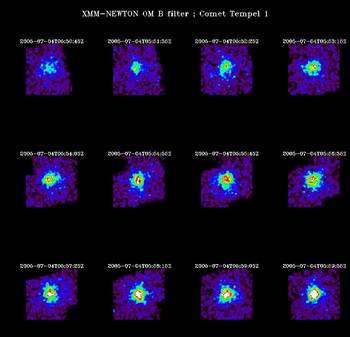First XMM-Newton images of impact

Images of Comet 9P/Tempel 1 taken by the Optical Monitor on ESA's XMM-Newton observatory, from two minutes before impact and until seven minutes after impact.
The first two images were taken just before impact, and in the following images the brightening due to impact is visible.
Hi-Res image available here.
These images were taken with the Optical Monitor blue filter, with which it is possible to measure the outcoming gas and dust. More images from the Optical Monitor are expected in the next hours.
Measurements with other XMM-Newton instruments should provide information about the chemical composition of the outcoming material.
XMM-Newton
Name The mission derives its name from its X-ray Multi-Mirror design. It also honours Sir Isaac Newton (1642-1727), the English physicist and mathematician. His demonstration that light can be split with a prism into its different colours forms the basis of the science that XMM-Newton is using.
Description XMM-Newton can detect more X-ray sources than any previous satellite. It is helping to solve many cosmic mysteries of the violent Universe, from what happens in and around black holes to the formation of galaxies in the early universe. It is built and designed to return data for a decade. XMM-Newton's high-tech design uses over 170 wafer-thin cylindrical mirrors spread over three telescopes. Its orbit takes it almost a third of the way to the Moon, so that astronomers can enjoy long, uninterrupted views of celestial objects.
Source: ESA

















